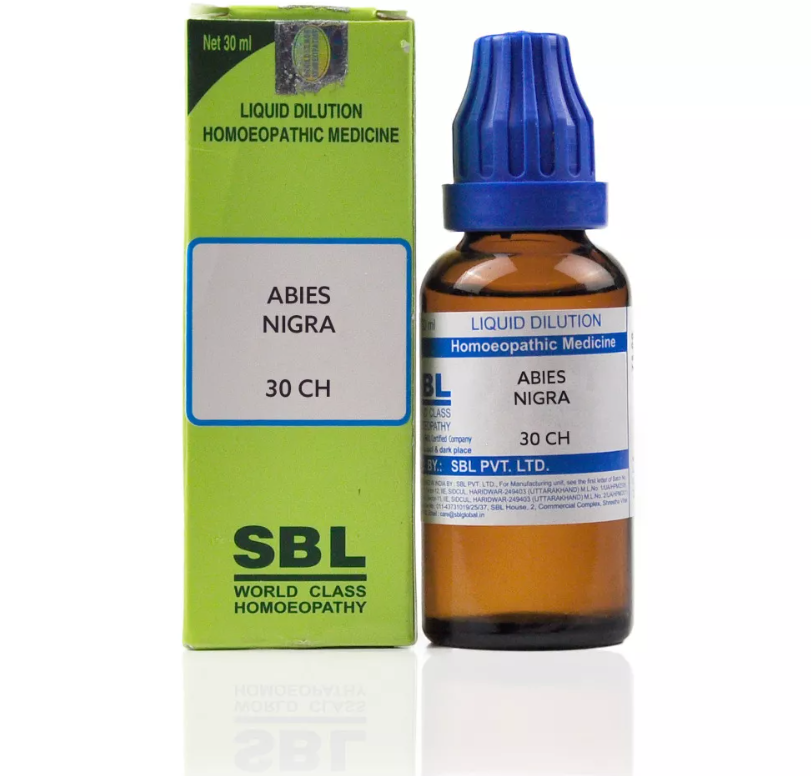Abies Nigra Q, 6C, 12C, 30C, 200C, 1M, 10M uses and symptoms
 Abies Nigra, also known as Black Spruce, is a potent remedy primarily addressing stomach-related issues. It’s particularly effective when characteristic stomach symptoms are evident. It is noteworthy for its impact on dyspeptic problems (Digestive Disturbances) associated with age, often accompanied by heart symptoms triggered by tea or tobacco consumption. Here’s a simplified overview:
Abies Nigra, also known as Black Spruce, is a potent remedy primarily addressing stomach-related issues. It’s particularly effective when characteristic stomach symptoms are evident. It is noteworthy for its impact on dyspeptic problems (Digestive Disturbances) associated with age, often accompanied by heart symptoms triggered by tea or tobacco consumption. Here’s a simplified overview:
Head: Hot with flushed cheeks, low spirits, daytime dullness, and nighttime alertness. Difficulty in clear thinking.
Stomach: Pain after eating, feeling of a lump in the stomach, distressing constriction above the pit of the stomach, loss of morning appetite, but craving food at noon and night. Offensive breath and dyspeptic eructations.
Respiratory: Sensation of something lodged in the chest, difficulty in fully expanding the lungs, worsened by coughing. Choking sensation in the throat, breathing difficulty when lying down.
Heart: Sharp cutting pain in the heart region, labored and slow heart action. May experience either rapid (tachycardia) or slow (bradycardia) heart rate.
Back: Pain in the small of the back, rheumatic pains, and bone aching.
Sleep: Restless and wakeful at night, hunger disturbs sleep, accompanied by bad dreams.
Fever: Alternating heat and cold, chronic intermittent fever with stomach pain.
Modalities: Symptoms worsen after eating.
In essence, Abies Nigra is a remedy for stomach issues with notable effects on digestion, heart symptoms, and sleep disturbances.
ABIES CANADESIS Q, 6C, 12C, 30C, 200C, 1M, 10M
SYMPTOMS OF Abies Nigra (Black Spruce)
 Head:
Head:
- Hot head with flushed cheeks.
- Low spirits and dullness during the day.
- Difficulty in clear thinking.
- Nighttime alertness, trouble falling asleep.
Stomach:
- Pain in the stomach after eating.
- Sensation of a lump in the stomach.
- Distressing constriction above the pit of the stomach.
- Loss of appetite in the morning.
- Strong cravings for food at noon and night.
- Offensive breath (halitosis).
- Dyspeptic eructations.
Respiratory:
- Sensation of something lodged in the chest.
- Difficulty fully expanding the lungs.
- Worsening with coughing.
- Choking sensation in the throat.
- Breathing difficulties when lying down (orthopnea).
Heart:
- Sharp cutting pain in the region of the heart.
- Labored and slow heart action.
- Tachycardia (rapid heart rate) or bradycardia (slow heart rate).
Back:
- Pain in the small of the back.
- Rheumatic pains and aching in bones.
Sleep:
- Restless and wakeful at night.
- Sleep disturbance due to hunger.
- Bad dreams.
Fever:
- Alternate heat and cold.
- Chronic intermittent fever with stomach pain.
Modalities:
- Symptoms worsen after eating.

selection of the potency
Individualization:
- Homeopathy is based on the principle of treating the individual, not just the disease. The unique symptoms and characteristics of the person are crucial in determining the most suitable potency.
Intensity of Symptoms:
- The intensity of the symptoms guides the choice of potency. If the symptoms are intense and acute, a lower potency (e.g., 6C, 30C) might be considered. For chronic conditions with less intensity, higher potencies (e.g., 200C, 1M) may be appropriate.
Sensitivity of the Patient:
- Some individuals are more sensitive to homeopathic remedies, while others may require higher potencies. The practitioner considers the patient’s sensitivity when selecting the potency.
Acute vs. Chronic Conditions:
- Lower potencies are often used for acute conditions, while higher potencies may be considered for chronic or long-standing issues.
Previous Response to Potencies:
- The patient’s response to previous homeopathic treatments helps guide the choice of potency. If a particular potency has been effective in the past, it may be repeated or adjusted as needed.
Vital Force and Susceptibility:
- Homeopathy views illness as a disturbance in the vital force. The practitioner assesses the patient’s overall vitality and susceptibility to determine the appropriate potency.
Aggravation or Amelioration:
- The direction of the symptom response (aggravation or amelioration) after taking a remedy can influence the choice of potency.
Miasmatic Considerations:
- In classical homeopathy, the concept of miasms (inherited disease tendencies) is considered. The practitioner take this into account when selecting the potency.
Practitioner Experience:
- The experience and preference of the homeopathic practitioner play a role. Some practitioners may have success with certain potencies based on their clinical experience.
SAFETY INFORMATION
- Do not exceed the recommended dose by physician
- Keep out of the reach of children
- Store in a cool dry place away from direct sunlight
- Maintain half an hour gap between food/drink/any other medicines and homoeopathic medicine
- Avoid any strong smell in the mouth while taking medicine e.g. camphor, garlic, onion, coffee, hing
Medicine images use for reference only selection of homeopathic medicine depends on the individual’s specific symptoms and overall constitution. Moreover, homeopathy is a holistic system of medicine that treats the individual as a whole. In addition to addressing the physical symptoms, it takes into account the emotional and mental state of the person. Consequently, it’s crucial to consult with a qualified homeopathic practitioner for personalized treatment.
The information provided on this website is intended solely for educational purposes. Always seek the advice of your physician or other qualified health provider.
